
Eucalyptus dives, commonly known as the broad-leaved peppermint or blue peppermint, is a species of tree that is endemic to south-eastern Australia. It has rough, finely fibrous bark on the trunk and larger branches, smooth bark above, lance-shaped or curved adult leaves, flower buds in groups of eleven or more, white flowers and cup-shaped, hemispherical or conical fruit.

Eucalyptus melliodora, commonly known as yellow box, honey box or yellow ironbark, is a species of medium-sized to occasionally tall tree that is endemic to south-eastern, continental Australia. It has rough, flaky or fibrous bark on part or all of the trunk, smooth greyish to yellowish bark above. The adult leaves are lance-shaped to egg-shaped, the flower buds are arranged in groups of seven and the fruit is more or less hemispherical.
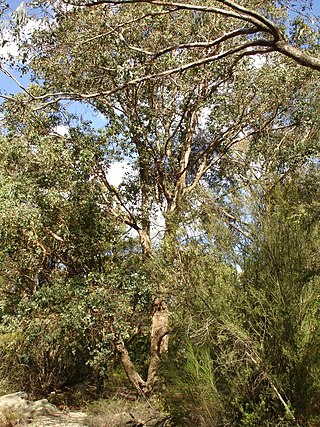
Eucalyptus baueriana, commonly known as blue box or round-leaved box, is a tree that is endemic to south-eastern Australia. It has rough, fibrous or flaky bark on the trunk and branches, egg-shaped adult leaves, oval to diamond-shaped flower buds arranged in groups of seven, white flowers and conical fruit.
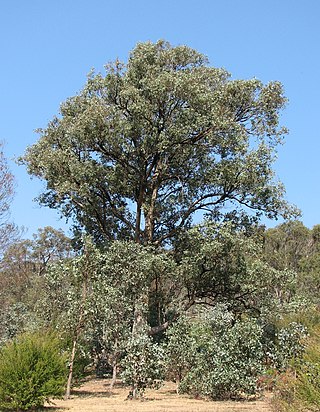
Eucalyptus polyanthemos, commonly known as red box, is a species of small to medium-sized tree, that is native to eastern Australia but has been introduced into other countries. It has fibrous bark on the trunk and larger branches, smooth greyish to cream-coloured bark above, or smooth bark throughout. It has broadly egg-shaped to round juvenile leaves, lance-shaped, egg-shaped or almost round adult leaves, flower buds in groups of seven, white flowers and barrel-shaped to conical fruit.

Eucalyptus miniata, commonly known as the Darwin woollybutt or woolewoorrng, is a species of medium-sized to tall tree that is endemic to northern Australia. It has rough, fibrous, brownish bark on the trunk, smooth greyish bark above. Adult leaves are lance-shaped, the flower buds are ribbed and arranged in groups of seven, the flowers orange or scarlet and the fruit is cylindrical to barrel-shaped or urn-shaped, with ribs along the sides.
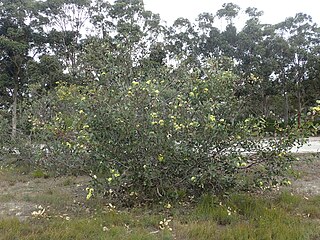
Eucalyptus preissiana, commonly known as bell-fruited mallee, is a species of small tree or shrub that occurs in an area between Albany and Esperance in Western Australia. It has a spreading habit, smooth bark, elliptical to egg-shaped or oblong leaves, flower buds in groups of three, yellow flowers and cup-shaped, conical or bell-shaped fruit.

Eucalyptus acmenoides, commonly known as white mahogany or barayly, is a tree that is endemic to eastern Australia. It is a large tree with grey to reddish brown, stringy bark, lance-shaped leaves, oval to spindle-shaped buds and more or less hemispherical fruits. The two sides of adult leaves are very different shades of green.

Eucalyptus dealbata, known as the tumbledown red gum or hill redgum, is a species of small tree that is endemic to eastern Australia. It has mostly smooth, white to grey or brownish bark, lance-shaped to egg-shaped adult leaves, flower buds in groups of between seven and eleven, white flowers and hemispherical fruit with the valves extended well beyond the rim of the fruit.

Eucalyptus angulosa, also known as the ridge fruited mallee or southern ridge fruited mallee, is a eucalypt that is native to Western Australia. The Noongar peoples know the tree as quarral or kwaral.

Eucalyptus capillosa, commonly known as wheatbelt wandoo, or mallee wandoo, is a species of tree or mallee that is endemic to Western Australia. It has smooth, grey bark, lance-shaped to elliptic adult leaves, spindle-shaped flower buds in groups of nine to thirteen, white flowers and barrel-shaped to cylindrical fruit.

Eucalyptus effusa, commonly known as rough-barked gimlet, is a species of mallee or small tree that is endemic to Western Australia. It has thin, rough bark on the base of the trunk, smooth bark above, linear to narrow lance-shaped adult leaves, flower buds arranged in groups of seven, white flowers and cup-shaped to conical fruit.

Eucalyptus leucophylla, commonly known as Cloncurry box, is a species of tree or mallee that is predominantly found in northwest Queensland with small populations possibly also occurring in the eastern Kimberley region Western Australia. It has rough, finely fissured bark, lance-shaped adult leaves, flower buds in groups of seven, creamy white flowers and cup-shaped fruit.

Eucalyptus oligantha, commonly known as the broad-leaved box, is a species of tree that is native to the Kimberley region of Western Australia and parts of the Northern Territory. It has rough, fibrous or flaky greyish bark, broadly egg-shaped to almost round adult leaves that are lost in the dry season, flower buds in groups of three or seven, creamy yellow to whitish flowers and cup-shaped to more or less cylindrical, bell-shaped or conical fruit.
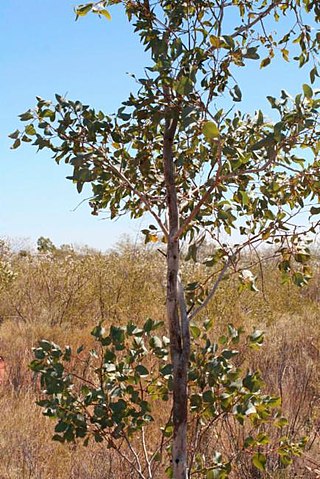
Eucalyptus pantoleuca, commonly known as round-leaved gum or Panton River white gum, is a species of small tree that is endemic to the Kimberley region of Western Australia. It has smooth, powdery bark, more or less round adult leaves, flower buds in groups of three, white flowers and conical fruit that are glaucous at first.
Eucalyptus subangusta is a species of tree, mallee or mallet that is endemic to the southwest of Western Australia. It has smooth bark, narrow lance-shaped leaves, flower buds in groups of up to nineteen, white flowers and cup-shaped to barrel-shaped fruit.

Corymbia clavigera, commonly known as apple gum or cabbage gum, is a species of tree that is endemic to a small area in the north-west Kimberley region of Western Australia. It has smooth, pale grey and white bark, lance-shaped or elliptical adult leaves, flower buds in groups of three or seven, white flowers and urn-shaped to barrel-shaped fruit.
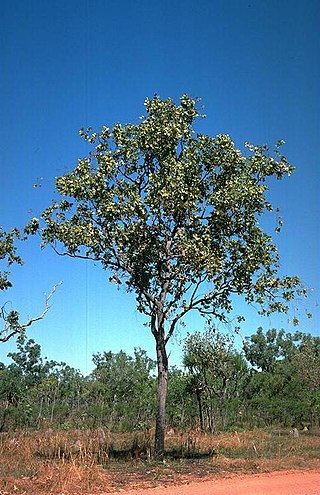
Corymbia ferruginea, commonly known as rusty bloodwood, is a species of tree that is endemic to northern Australia. It has rough, tessellated bark on the trunk and branches, a crown of sessile juvenile leaves, flower buds in groups of three or seven, pale creamy yellow flowers and urn-shaped fruit.

Corymbia setosa, commonly known as rough leaved bloodwood or desert bloodwood, is a species of small tree that is endemic to north-eastern Australia. It has rough, tessellated brown bark on the trunk and branches, a crown of juvenile, heart-shaped leaves arranged in opposite pairs, flower buds in groups of three or seven, white flowers and urn-shaped to shortened spherical fruit.
Eucalyptus tephrodes is a species of small tree or mallee that is endemic to Western Australia. It has rough bark on the trunk and larger branches, smooth bark above, egg-shaped to lance-shaped adult leaves, flower buds in groups of three on the ends of branchlets and cup-shaped to hemispherical fruit.
Eucalyptus lockyeri, commonly known as Lockyer's box, is a species of small tree endemic to a small area in Queensland. It has rough bark near the base of the trunk, smooth bark above, lance-shaped adult leaves, flower buds in groups of seven, white flowers and hemispherical fruit.




















